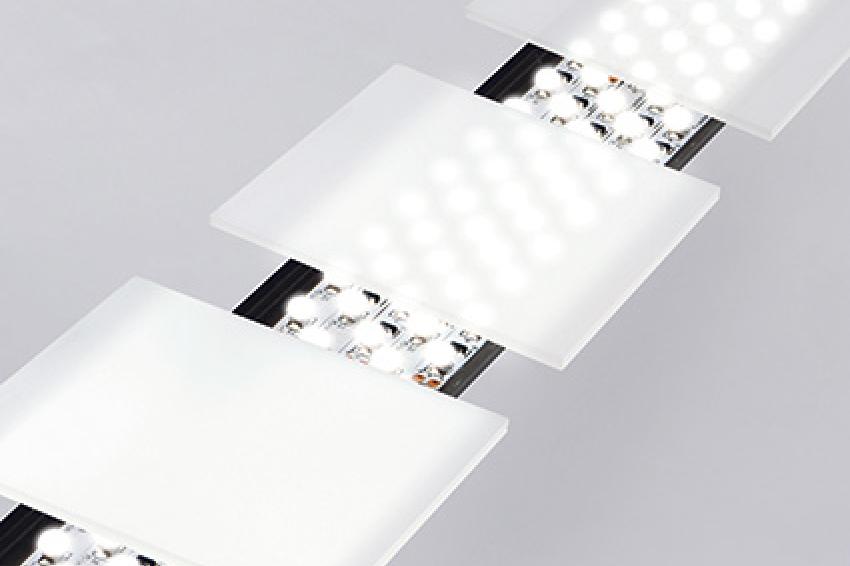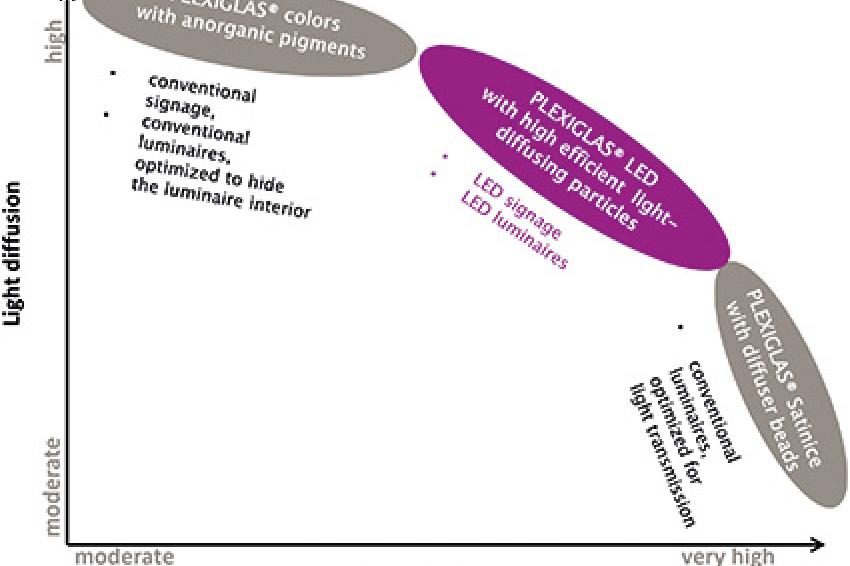Plexiglas and LEDs for the Right Combination
31.01.2014 -
Fixing The Fixtures - LEDs save energy. But to put this to the best advantage, light fixtures need to be adapted to the technology. The right lighting covers made from a special grade of Plexiglas make a key contribution.
Even in daytime, innumerable light fixtures light up offices, factories and public buildings. So it's not surprising that lighting accounts for about one-fifth of global energy consumption. This proportion harbors enormous savings potential.
As a number of surveys reveal, most of the lighting technology used today is outdated. In Germany, for instance, more than 9 million streetlights guide us through the dark and consume 4 million kilowatt-hours of electricity each year. Calculations by the German Association of Towns and Municipalities show that 40% of this figure could be saved by installing modern, energy-efficient street lighting, which would cut energy costs by more than €300 million per year.
Light-emitting diodes, or LEDs, are seen as the key to energy-saving lighting. This technology offers higher luminous efficiency combined with lower energy consumption and a wide range of colors. LEDs are so small that they offer completely new design options for light fixtures. Depending on the manufacturer, they also offer a service life of up to 100,000 hours. Their low maintenance makes them particularly attractive for use in public buildings and industry. That is why LEDs are ousting classical light sources from the market in the professional lighting sector.
Only the Right Combination Provides Efficiency
But a power-saving light source alone is not enough to provide energy-efficient lighting. If inefficient ballast units or transformers consume a lot of electricity, even the most energy-saving LED technology is of little use. The same applies to the optical light cover. If this is not suitable for guiding light to where it is required, the input energy is not efficiently used. That in a nutshell is the challenge for this material in combination with LED technology.
Since the LED light source is a small but very powerful spotlight, it is important to avoid intensive points of light that might dazzle the viewer. The optical material surrounding the LED must therefore be able to guide the light precisely in the desired direction, like a special lens, or to distribute it evenly across a surface.
Manufacturers of light fixtures and their suppliers usually fabricate light covers from transparent and translucent plastics that serve various purposes. Each light, from street lighting to living room and office lighting, makes specific demands on light guiding. Plastics manufacturers therefore have to provide the corresponding materials.
Materials that were specially designed to meet the requirements of LED technology are grouped together in the Plexiglas LED product family. From molding compounds to semi-finished materials, products from Evonik Industries AG in Darmstadt can be used to make both crystal-clear and structured covers, as well as light-diffusing covers.
Guiding Light
Lighting applications have different goals. Streetlights, for example, are meant to light up the street, not the space around the light source several feet up in the air. In supermarkets, lights are supposed to illuminate the displayed products. In offices, they should light up the workplace. In each case, the covers used are made of materials with fine prismatic structures that efficiently guide the light to where it is needed. Manufacturing these structures calls for forming processes and a material with extremely precise mold-surface reproduction characteristics - like crystal-clear Plexiglas, with its ease of flow and good mold release.
Backlighting without Hot Spots
Other types of lighting call for light diffusion rather than light guiding, to distribute brightness evenly throughout the room. LED light is pointlike. Without a light-diffusing cover, it would create many small points of light that are dazzling and significantly reduce visual comfort. For damp-room lighting in cellars or warehouses, that is not enough to create the required brightness.
Another challenge is involved if the cover does not diffuse the light sufficiently. This leads to undesired bright areas, so-called hot spots. There is a greater risk of such hot spots in the compact light fixtures that can be designed with LEDS. Because of the smaller size and lower heat load of LEDs, the covers are often positioned closer to the light source. The material must be able to diffuse the luminosity of LEDs in the room without light losses, while guiding light evenly across the surface. Evonik has developed special grades of the Plexiglas LED family, providing a new generation of light-diffusing material that offers a balance between light diffusion and light transmission. These new products close the gap between conventional white grades with high diffusion but low transmission, and the diffuser materials that show enough diffusion but high transmission (see figure).
Slim Design
LEDS have another major advantage besides energy efficiency. With their focused light and small size, they enable entirely new lighting concepts such as edge lighting. In this technology, the LED light is fed into a light-guiding structure via the edges, illuminating the entire structure. What is more, the light-guiding structure remains crystal-clear even when unlit. What is more, the light-guiding structure remains crystal-clear even when unlit. This enables slimmer designs and smaller installation depths. The condition is that the molded parts provide light output across the entire surface.
The edge-lighting grades of the Plexiglas LED family meet this requirement because they incorporate special light-diffusing particles. However, since the area to be illuminated plays a crucial role in this type of lighting, the material is available in various grades that allow for homogenous light output across a component size of up to almost one meter. In panel lights, for instance, which are incorporated into the ceiling, edge lighting ensures uniform lighting of rooms. This technology is becoming more and more popular in Asian countries, where it originated. In ambient and contour lighting, too, compact edge lighting fixtures offer designers new options for delicate light elements in interiors or vehicles.
The possibility of lighting slim components via the edges is only one example of how LED technology is transforming the entire lighting industry. Owing to the growing focus on energy efficiency, new designs are almost entirely based on LEDs. That reduces the environmental load and cuts costs.
Meanwhile, LED technology has attained an attractive cost level for everyday use. Nevertheless, a certain degree of caution is advisable. Despite all the benefits of LED technology, only the correct combination of materials provides the desired savings.
It has become harder for the layperson to recognize good technology at a glance. Yet LED technology is attractive not just for professional applications in public buildings and industry, but also for household use, which represents another area for new lighting industry developments. In order to provide the corresponding materials in response to new trends, Evonik has been working with regional development partners for many years to come up with future-ready lighting solutions.










